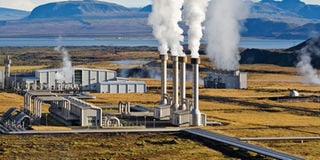Geothermal power: Kenya's lesson to uganda

Geothermal energy can help fight energy shortage. Internet photo
Built on an 80 square kilometre piece of land, Olkaria is Africa’s largest geothermal power plant producing 167MW- enough to serve over 500,000 households. Though not part of the attraction in Hell’s Gate National Park in Kenya, the huge maze of pipes, used to carry steam from underground, make an attraction of their own.
The atmosphere smells of rotten eggs, an indication of the presence sulphur gases in the air. Also, hot springs can be spotted at various locations.
This is one of the ways to know whether hot rock or magma, used in production of this energy, exits underneath.
“You can also tell by existence of geysers, tumaroles and natural sulphur coming out of the ground,” explains Henry Wesula, the senior operations manager of KenGen, a state owned power producer.
According to KenGen, the current ongoing expansion is to provide Kenya with 1260MW by 2018. Although it cost the country $1.6b (about Shs4.1 t), Wesula says it eventually pays off as operation costs are very minimal, the energy source is renewable and production can be done throughout the year. Currently, geothermal energy contributes 10 per cent of Kenya’s energy supply and is projected to increase to 7,000 MW by 2030, providing half of Kenya’s energy.
“In the 80s when we entirely relied on hydro power, we had a very severe drought and had an over 70 per cent power rationing. we do not want that to happen again so we are having a mix of all energy,” said Wesula, adding, “We are planning to set up a coal plant in Mombasa, further developing the wind energy project to avoid any hitches in power supply.”
It was not a smooth road for Kenya to reach where they are. After its first production in the 1970s, the project stalled in 1992 only to be revamped in 2003 when the government started investing in the project again.
Ideas for Uganda
Wesula says, not only would exploration of geothermal energy provide Uganda with alternative energy sources but also would help the country achieve its vision of becoming an industrialised country in the next few years.
“We already know that Sudan and Egypt are against building dams along the Nile, in the event of a problem there will be no other source of energy for Uganda,” Wesula said adding, “Any country that wants to be industrialised can’t afford to have power rationing.”
According to Diana Taremwa from the Africa Institute for Energy Governance, Uganda is currently on the brink of yet another load shedding roaster due to electricity demand outpacing supply.
This would be aggravated by the country solely depending on hydro for her clean energy. Last year, Uganda Electricity Transmission Company Ltd (UETCL) projected that demand for electricity was to increase from 10 to 15 per cent this year, whereas electrification rate is stagnant at only 12 per cent.
UEGCL, the owner of the Kiira and Nalubaale hydropower stations which have a combined capacity of 380MW, averagely produces only 180MW. “Producing geothermal project will enable substantial increase in the provision of additional reliable and clean power generation capacity to Ugandan households, businesses and industries which will in turn improve electricity coverage in Uganda,” Taremwa said.
A geophysical survey by KenGen, revealed that Uganda has an estimated 400MW of untapped geothermal energy, mostly locally in the western part of the country where the Great Rift Valley and escarpment is located.
“Geothermal technology is equally important in an economy still faced with inefficient power supplies-evidence being that the much hyped 250MW that came on line last year has already been swept off the grid,” Taremwa said adding, “To compare oil and geothermal energy, you need to appreciate the multiplier effect created by a refinery - chemical production, fertilisers for the agricultural sector, jet fuel, petrol, kerosene, plastics and many more others but the two are very important for the economic development of Uganda.”




